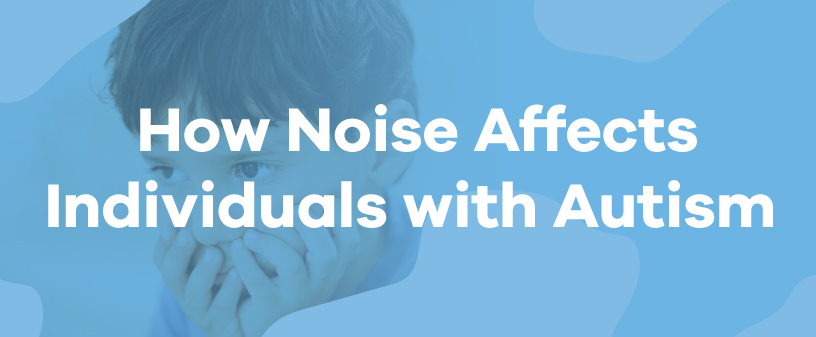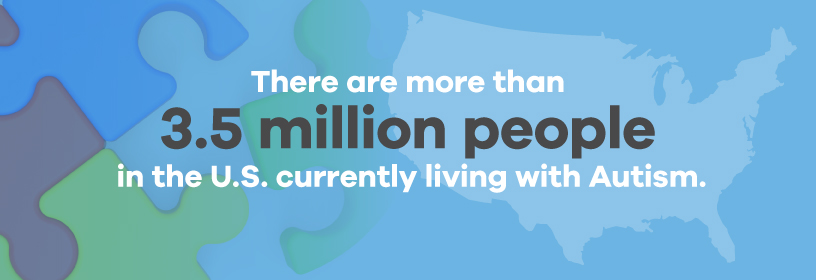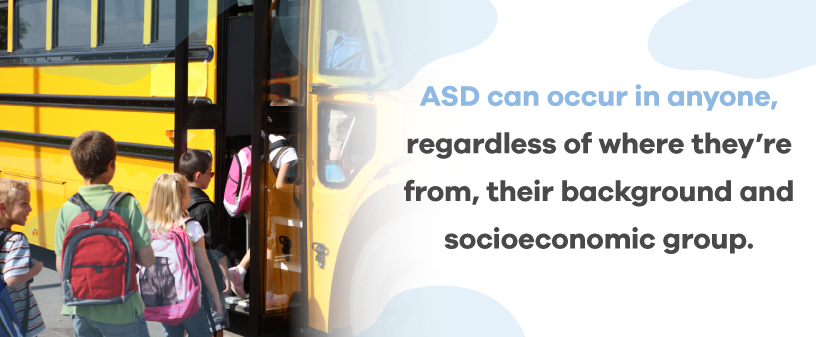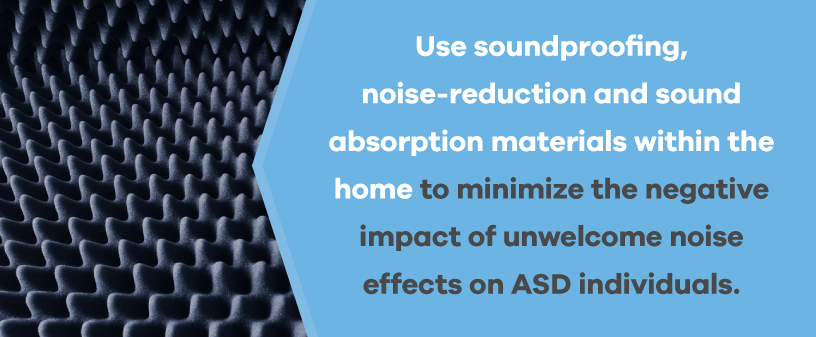

Certain sounds are particularly annoying to us all collectively. For many people, the sound of someone scraping their nails down a blackboard or the high-pitched squeal of microphone feedback can be excruciating to hear. However, if you have autism, many of the everyday noises other people take for granted can be very painful and cause unwanted intrusions.
According to the Autism Society, there are more than 3.5 million people in the U.S. currently living with Autism. The condition makes you feel, see and hear the world differently than other people. Lifelong developmental disability affects each individual differently.
As an autistic person, your world can often feel overwhelming, which can be the source of a great deal of stress. It’s generally more challenging for you to relate to and understand others — even everyday communications, surroundings, activities and tasks can sometimes prove problematic.
Fortunately, all children and adults can benefit from therapies, interventions, strategies and tools that aim to reduce autistic and sensory overload symptoms and increase functioning, abilities and skills. This guide provides background information on autism and sensory overload disorders — particularly how noise and sounds affect individuals with autism. It also provides strategies, tools and resources to help people with autism better cope and manage their symptoms.
Key Autism Statistics
When trying to understand autism, it’s good to have the facts and figures in front of you. Some key autism spectrum disorder (ASD) statistics from the Centers for Disease Control and Prevention include:
Prevalence
Between 2009 and 2017, around one in six U.S. children between the ages of 3 and 17 had a developmental disability such as autism. Approximately one in every 36 children in America is diagnosed with autism spectrum disorder.
Demographics
One in 23 boys has an autism spectrum disorder. In girls, the figure is one in 87, indicating that the condition is slightly less than four times more common in boys than girls. ASD can occur in anyone, regardless of where they’re from, their background and socioeconomic group.
IQ Testing
44% of children with ASD have intellectual abilities that are considered to be above average.
Diagnosis
While an autism diagnosis in children as young as age two can be accurate, children are most often diagnosed at age four and above.
Social Impact
25% to 30% of those diagnosed with autism do not speak or use minimal verbal communication. Two in three children with ASD between 6 and 15 years old have been subjected to bullying.
Potential Factors
Older parents are more likely to have a child with ASD. Parents who already have one child diagnosed with autism run a 2 to 18% chance of having another child with the condition.
Twins
In identical twins, if one sibling has ASD, there’s a 36 to 95% likelihood of the other twin being on the spectrum. In the case of non-identical twins, where one child has ASD, the other will be affected between zero and 31% of the time.
Cost of Care
From medical care to lost parental productivity, the average total costs per year for U.S. children on the autistic spectrum in 2015 amounted to $268 billion and is expected to reach the $461 billion mark by 2025.
Physical and Emotional Symptoms Autistic Individuals Experience
Arguably, the key to understanding autism is to know the ways that it affects you or your child on both a physical and emotional level. While there are three core autism symptom categories — namely social deficits, language impairment and repetitive behaviors — your child may face other overlapping issues, conditions and challenges.
One of the most particularly challenging yet manageable is sensory overload. A common telltale symptom among individuals with autism is reacting unusually to certain sounds, tastes, smells and textures.
When you’re on the autistic spectrum, it’s almost as though you have some of your senses turned up too high, whereas others seem to be too low. For example, you may over- or under-react to loud noises or pain. You may also be unable to touch certain fabrics, or they can feel very uncomfortable against your skin.
In addition to the sensory overload experiences described above, generally speaking, if you have ASD, you may also:
- Not respond to your name by the time you’re a year old.
- Not point at objects to show your interest by the time you’re 14 months old.
- Not play “pretending” games by the time you’re 18 months old.
- Have distinct trouble discussing your feelings and understanding those of other people.
- Want to be alone most of the time.
- Have delayed language and speech skills.
- Have interests you’re obsessive about.
- Be very upset by even the smallest of changes.
- Repeat words over and over (echolalia).
- Display fearlessness or fearfulness.
- Only interact with others to achieve a desired goal for yourself.
- Have no understanding of the concept of personal space boundaries.
- Not be comforted by other people when you’re distressed.
- Not use hand gestures in the way others do, for example, waving goodbye.
- Talk in a singsong or flat voice.
- Have difficulty understanding teasing, sarcasm and jokes.
- Act without thinking.
- Follow set routines.
- Demonstrate unusual emotional reactions and moods.
On a physical level, other symptoms are generally known to be related to the autistic spectrum. If you have ASD, you may:
- Display hyperactivity.
- Exhibit aggression.
- Show a short attention span.
- Spin in circles, flap your hands or rock your body backward and forwards.
- Have self-injuring tendencies.
- Have temper tantrums.
- Avoid physical contact.
- Avoid making eye contact.
- Have inappropriate or flat facial expressions.
- Be exceptionally organized.
- Exhibit unusual sleeping and eating habits.
- Enjoy lining up objects and will like specific parts of said objects.
As you can see, an individual with autism can face many symptoms. As a spectrum disorder, these symptoms can vary in intensity, frequency and severity.
Understanding Noise Sensitivities in Individuals With Autism
There are links between autism and auditory sensitivity. If you have autism, you may overreact or completely ignore many ordinary sensations, smells, sights and sounds. It’s thought that this is because you’re processing information from your senses differently than others not on the spectrum.
For instance, you might not filter out irrelevant noises or find that certain sounds can be very uncomfortable and distracting.
If you’re autistic, there are various types of noise sensitivities you may experience, including:
Misophonia
This is characterized by an emotional reaction to certain sounds, such as rage or anger. The trigger for this is usually a soft sound often related to breathing or eating and can be connected to people close to you. For example, you may be driven to distraction by the sound your significant other makes when they chew their food. However, a similar noise made by someone else may not even bother you in the slightest.
Phonophobia
Also called sonophobia or ligyrophobia, phonophobia is an unusual and persistent fear of either specific or general environmental sounds. If you have phonophobia, you may try to avoid ever exposing yourself to the sounds you’re scared of and could, in time, end up being housebound due to your anxiety.
Hyperacusis
Often accompanied by tinnitus, hyperacusis is an intolerance of everyday generalized environmental noise.
Hypersensitive Hearing at Certain Frequencies
This issue often goes hand-in-hand with autism. When you’re suffering from this, you can likely handle most sounds as long as they’re at a regular level. However, this changes when the sounds change frequency, particularly when they rise above 70 decibels – say, when you hear a vacuum cleaner running.
Recruitment
This is a sudden, painful and shocking increase in the perception of sound directly related to dead or damaged hair cells within the inner ear.
As you’ll likely realize, these noise sensitivities can be incredibly life-altering and upsetting to both the affected individual and their friends and family. That’s why it’s incredibly important to find ways to reduce sound sensitivity and implement sound solutions for home, work and play.
Challenges Families Face in Overcoming Autism Symptoms
Often, as a family member of someone with autism, you can feel helpless in terms of assisting your loved one to overcome the challenges they’re facing.
When your loved one is on the autism spectrum, he’ll likely face daily issues, challenges and problems. Issues that can regularly occur include:
- Facing additional conditions, such as gastrointestinal problems or epilepsy
- Finding it difficult to socialize with others
- Issues relating to sound, feel, touch and taste
- Having difficulties communicating with people
- Feeling generally frustrated at having to deal with people’s prejudice and ignorance about their condition
- Feeling ignored as a result of their autism
If you’re caring for someone who is autistic, you may also be facing your own issues and problems, such as:
- Worry
- Exhaustion
- Caregiver burnout
- Frustration in finding solutions
- Inability to cope at times
- Your own health issues
This is why it’s so incredibly important that autistic people, their loved ones and caregivers find services, treatments and therapies that will assist.
Strategies to Help Individuals With ASD Respond to Severe Sensory Overload
Activities many take for granted, such as going to the grocery store, can be challenging for those with autism. Many people experience a heightened sensitivity to several stimuli experienced by the body’s senses, including loud noises or sounds above 40 decibels. The result is often extreme discomfort and a desire to flee the environment, not to mention that these situations can often be emotionally and physically draining for someone with autism.
Developing suitable coping mechanisms to deal with potentially overstimulating spaces is essential. And there are several approaches you can consider to help your loved one suffering from noise sensitivity and other sensory overload difficulties. Various strategies work for different people, so think about how the stimuli affect your loved one and what you can do to minimize their exposure and discomfort.
Sound Sensitivity
Hypersensitivity to loud noises is one of the most common sensory challenges individuals with autism experience. Loud and overwhelming noise is everywhere, including in public spaces, at school or work and even at home, where there’s a degree of control. Noises that others can often tune out with little thought are not as easy for those with autism to ignore and can impede their ability to concentrate, communicate or function. Fortunately, you can find ways to overcome these situations, including the following effective strategies:
- Pinpoint and take note of the sounds that cause your loved one discomfort.
- Limit the use of headphones or earplugs when possible, but keep a set on hand for particularly stressful situations.
- When exposed to noisy environments, ensure you set time aside for quiet time away from the noise. Creating a dedicated quiet space by soundproofing a room may offer relief.
- Take note of quiet spaces where your loved one feels comfortable and safe.
- When experiencing sensory overload, try introducing a distraction using something they enjoy, like a favorite toy or keepsake.
- Allow your loved one to experience loud noises from a distance before introducing them to the noisy environment. This process can allow them to become familiar with the sound and reduce stress.
- Offer the individual with autism an opportunity to control the offending sound where possible to encourage familiarity. This exercise could include honking the car’s horn or switching noisy appliances on and off.
- Make specific rooms of your home safe, quiet zones using soundproofing materials that act as a barrier to loud, uncomfortable noises.
- Muffle sounds from communal spaces at home, work or other areas you have control over using various sound absorption solutions designed for different situations.
- Decorate your home’s corridors and common living areas with custom art acoustic panels to offer a degree of soundproofing with style.
- Encourage restaurants, churches, stores and other places you regularly visit in your community to consider incorporating commercial soundproofing or sound absorption materials in particularly noisy areas for those with noise sensitivity.
- Speak to your loved one about volunteering at a quiet place, such as the local library or bookstore.
- Try muffling the noise of chair legs scraping on the floor by gluing cut pieces of carpeting to the bottom of the chair legs.
- Install carpets to muffle sounds.
- Encourage your loved one to get out and take a walk in nature on a daily basis.
- Arrange your schedule to ensure you visit typically crowded areas during off-peak hours.
Visual Sensitivity
While sensitivity to visual stimuli is something many people deal with, it can be more challenging for people with autism. This sensitivity often relates to bright lights, specifically LED and fluorescent lights. However, the following tips could help your loved one deal with visual sensitivity when needed:
- Limit the number of trips you take to the supermarket if your loved one is upset by the lights.
- Replace fluorescent bulbs with the incandescent variety if they cause discomfort to your family member.
- Encourage your loved one to wear sunglasses to reduce visual overload in challenging circumstances.
- Add blinds or room-darkening curtains on windows to keep bright sunlight at bay.
Food Sensitivity
For those with autism, foods with a unique or strong taste or those with a specific type of texture can be off-putting, which often includes fruits and vegetables. To avoid conflict at mealtimes, you can take a different approach with these strategies:
- Don’t force your loved one to eat foods they’re sensitive to. For example, avoid chips and jello if they have issues with crunchy and slimy foods.
- Observe their reactions to different foods to see which cause sensory pain and which they don’t care for.
- Encourage your loved one to take a small bite of healthier foods they’re unsure of to nurture familiarity and develop a balanced diet.
Touch Sensitivity
Touch sensitivity can relate to the feel of textured fabrics, such as knitwear, on the skin or the proximity of others in some situations. Here are a few pointers to follow when helping your loved one with autism:
- Don’t force anyone with ASD to wear or touch fabrics and materials that cause them stress.
- Buy soft, comfortable clothing your loved one approves of in bulk.
- Keep your distance if you’re too close to your loved one and they show signs of discomfort.
Smell Sensitivity
Neurological studies have found that people with autism process scents differently from others, which explains their heightened sensitivity to strong and unusual smells. Consider these tips:
- Observe and take note of the scents that cause your loved one discomfort.
- Limit exposure to problematic fragrances or strong smells and get into the habit of buying unscented products.
- When visiting public spaces, ensure you have a tissue or handkerchief handy for your loved one to cover their nose if faced with pungent odors.
Professional Therapies to Help Treat Sensory Overload
Thankfully, there are several studied and proven therapies to help with sensory overload relating to ASD.
- Cognitive Behavior Therapy: For phobias, anxiety disorders, autism and other conditions, experts often recommend cognitive behavioral therapy as it teaches the person how to cope and self-manage their emotions.
- Sensory Integration Therapy: As a known therapy to help people with ASD or sensory overload difficulties, sensory integration therapy helps children and adults with autism improve their daily functioning.
Additional Resources for Autism and Sensory Overload
Autism Speaks, the world’s leading autism science and advocacy organization, along with other prominent organizations, provides resources to help autistic individuals and parents of children with autism or a sensory overload disorder, including the following:
- Autism Speaks: Sensory Tools and Products
- Autism Speaks: Services and resources by state
- Autism Source: Database
- Association for Science in Autism Treatment: Resources for Parents and Educators
- Centers for Disease and Control: Free Autism Materials
- Organization for Autism Research
Autism is a lifelong condition without a definitive “cure.” As our society continues to learn more about autism, there are more and more ways to help support people who have it. Through early detection, structured support and strategies to minimize symptoms, you can successfully manage the condition so that you or your family member can live a fulfilling life.
Through this guide, we hope that you’ve increased your understanding of the world of an ASD person, particularly in the areas of noise sensitivities and other sensory overload challenges. We hope that you find the tips, advice and noise solutions for autism presented above to stop sensory overload helpful in managing the condition for yourself or your loved one.
Call 1-866-949-9269 today to speak to a Soundproof Cow team member to learn more about soundproofing a home for individuals with autism.
Learn More About Soundproofing for Disabilities
How to Reduce Auditory Sensitivity
Soundproofing Solutions for Misophonia
Soundproofing Solutions for Tinnitus

I just wanted to let you know that in the end, sealing the air spaces on this door worked just fine and took care of the problem.
I really appreciate you taking so much time to share your expertise with me, and in particular recommending I try the simpler solution before investing in more expensive noise barriers. That is a big credit to you and your business.
- Mike



